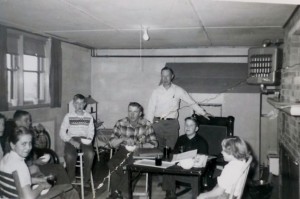Bob Frankenstein’s experience with the Leipsic 4-H Club in Dodge County began almost 7 decades ago, and the lessons he learned have stuck with him to this day. Read more about Bob’s 4-H story:
I was a farm boy growing up during the early 1940s and everyone was struggling with the Depression and the fear of a World War. These country life memories are as vivid now as when I lived them in my early years. The Depression, World War Two, Korean, and Vietnam wars were a part of the environment during which Leipsic 4-H history was made. Leipsic 4-H mindset was always relevant to the time and so projects were based on real life, adjusted to the level of each member’s maturity.
The Wisconsin 32nd Division was called to active duty the fall of 1940, Beaver Dam had its first blackout air raid drill on July 1st, 1941 and the dreaded World War was declared December 1941. My older friends and cousins were drafted and rationing would soon take its toll on the home front.
Depression life in the farming community forced farmers to be frugal, thus there were many more farm horses than tractors to work farmland and much antiquated equipment at the time.
A few lucky farmers bought new tractors during the 1940 and 1941 window of opportunity as the Depression was ending and just before war rationing began. My Dad bought a John Deere model B tractor, an Allis Chalmers combine (which replaced the threshing machine) and a Plymouth car during this period. He also bought a blacksmith forge and tools with which he converted all the horse-drawn equipment to tractor-pulled style over a two or three-year period. It was one my jobs to crank the hand blower supplying air to the forge.
The raging war demanded more and more food and raw materials, so farmers had to adapt their Depression-era horse-drawn machinery to be pulled by the new iron horse. Everything needed by farmers was rationed or not available so farmers had to trade in horses for already ancient tractors or used equipment at a dealership or maybe buy old equipment at a farm auction. Old cars were made into homemade trucks and old ideas had to be abandoned.
Milking was done mostly by hand after which the milk was cooled with water pumped by a windmill or a gas engine and then hauled in cans to the neighborhood cheese factory. There were pea-vine machine installations which separated peas from the pods always within a mile or two and sweet corn was harvested by hand and hauled to a nearby canning factory. Our neighbors worked together to form a mutual grain threshing pool at harvest time known as our threshing route. Dodge County would produce more peas and sweet corn for the war effort than any other county in the country.
Electric power sponsored by Columbus REA Cooperative started to arrive in our area about 1940, changing everything. They set up a highline post transformer between the Herman Bilke farm and our farm, from which power came to our house. My Dad rushed to adapt electric motors to a newfangled Sear’s Farm Master milking machine and well water pump jack. The windmill was left on as backup. Dad and my Uncle Alvin worked long hours to replace oil lamps, battery lights and candles with new electric lighting in the house and barn. They even put something called a yard light on the house.
Dad bought the John Gunn farm in 1942 and a used 1938 W. C. Allis Chalmers tractor. The John Gunn farm had no electric service so it had to be wired when the high voltage power lines arrived sometime later. Dad sold our horses Diamond and Star when this was done. It was a sad day for me when I saw them taken away!
During this time I was longing for something special. I begged my Dad to allow me to join the Leipsic 4-H club but I could not join until I was old enough.
Finally my day came and I got to go to the 4-H meetings at Leipsic School along with my siblings. Our farm was located between Jackson School (where my sisters attended classes) and Leipsic School. However…Leipsic School was the better! It had indoor plumbing whereas Jackson School had an outhouse and water had to be carried from the Jake Hammer farm.
I was a little overwhelmed and intimidated for the first several meetings. I struggled to learn the 4-H pledge. Our club leaders were Mr. and Mrs. Harry Welch. They were assisted by Henry and Margaret Haas and several other exceptional project leaders.
Demonstrations were required from each one of us members. One might demonstrate how to plant potatoes, how to safely change an electric fuse, how to sew a dress from colorful flour bags, how to groom a calf or even how to shear wool.
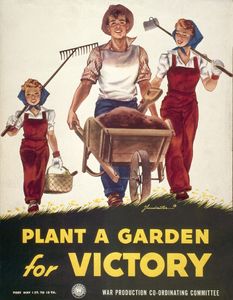 4-H Victory Gardens was to be the one main project of the club, along with the farm calf and chicken raising projects. Sewing, first aid, babysitting, gardening, canning and learning to cook with honey or sorghum syrup were big choices with the girls. War rationing took away such things as sugar, metal toys, bicycles, tires and rubber erasers, but these shortages also encouraged salvaging of cloth, metal, rubber and tin foil as goals for the 4-H boys. Everyone including me also gathered milkweed seed for military lifejackets and some even collected urine from pregnant horses (which was needed to make penicillin).
4-H Victory Gardens was to be the one main project of the club, along with the farm calf and chicken raising projects. Sewing, first aid, babysitting, gardening, canning and learning to cook with honey or sorghum syrup were big choices with the girls. War rationing took away such things as sugar, metal toys, bicycles, tires and rubber erasers, but these shortages also encouraged salvaging of cloth, metal, rubber and tin foil as goals for the 4-H boys. Everyone including me also gathered milkweed seed for military lifejackets and some even collected urine from pregnant horses (which was needed to make penicillin).
Victory gardens had to be planted, weeded and harvested. I and my siblings hated the tedious picking of potato bugs off each plant one bug at a time and then dropping each bug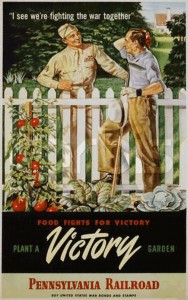 into a tin can half full of water, while sweltering under the hot sun. I soon realized I didn’t like hoeing in the garden any better, while being devoured by hungry mosquitoes. However, 4-H project leaders encouraged us along the way and my parents promised us three dollars to go to the fair if we did a good job weeding the garden.
into a tin can half full of water, while sweltering under the hot sun. I soon realized I didn’t like hoeing in the garden any better, while being devoured by hungry mosquitoes. However, 4-H project leaders encouraged us along the way and my parents promised us three dollars to go to the fair if we did a good job weeding the garden.
My mind was preoccupied with the thought that the annual 4-H inspection tour was coming to review my projects and everyone would be likening my work with the rest of the members. Some on-farm demonstrations were done at this time, also. The auto tour included a nice picnic break on someone’s farm before moving on for the afternoon portion of the inspection tour.
We also had to prepare to show the fruit of our labor at Dodge County Fair. I would pick out the best and largest seeds from our oat and wheat harvest to show at the fair. The same with samples of potatoes, cucumbers and carrots. Premiums were paid on white, red and blue ribbons and best of show winners, so I did the best I could.
We had to keep records of our work hours, costs and profit or new value of each project. These records had to be finished after the fair and judged before the award night meeting.
4-H life included a pleasant social life. I admit to having a crush on a couple of the girls during my 4-H days. A wedding or two resulted from the companionship shared by the 4-H community including my own. There would be 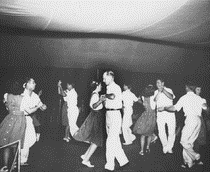 square dancing or group singing and a treat after each monthly meeting. My Dad owned several dance and music records and played them after many meetings. If he or someone else wasn’t calling square dancing to music like “Skip To My Lou My Darling” with Roy Rogers or Gene Autry, he might play songs like “Clementine” or “Roll Me Over in the Clover” or “When Johnny Comes Marching Home” for us all to sing. I still have those records saved in my home. Once in a while the girls would perform several tap dance routines to the delight of all in attendance.
square dancing or group singing and a treat after each monthly meeting. My Dad owned several dance and music records and played them after many meetings. If he or someone else wasn’t calling square dancing to music like “Skip To My Lou My Darling” with Roy Rogers or Gene Autry, he might play songs like “Clementine” or “Roll Me Over in the Clover” or “When Johnny Comes Marching Home” for us all to sing. I still have those records saved in my home. Once in a while the girls would perform several tap dance routines to the delight of all in attendance.
Project meetings were usually held in the private home of the project leader unless someone else volunteered their home. Playing romantic music records and singing folk songs while sitting on the floor around the record player or maybe sharing a winter sled party on a nearby hill was great fun after a project meeting.
There were also 4-H baseball tournaments in someone’s farm pasture during the summer. We had to be careful not to step into a cow pie while playing ball.
Each club presented an annual play. It was fun to compete for best actor or actress and best 4-H play during the winter. I remember having to play a girl’s part complete with the stuffing on my chest to make me look like a girl. Mrs. Haas talked me into it because she needed another girl in the play. I was so embarrassed!
Once a year Charlie Starkweather (a local businessman) would install our newly elected officers, give out our project awards and treat us to his hometown movies. It was his hobby to take movies of local Beaver Dam community events. You could find him faithfully recording 1930 – 1950 events including: barn and house fires, construction progress of the new Beaver Dam water tower, the first new Beaver Dam wastewater plant, and new Hotel Rogers, or he might be capturing really bad storms, life in our local German Prison of War camp and Indian or circus night in the park.
He skillfully used his hand-cranked silent movie camera to record local history and we members of the Leipsic 4-H Club loved it. He shared jokes and everyone was fascinated with his presentations. Those films are preserved in the Dodge County Museum in Beaver Dam.
When World War Two ended great joy spread over the community.
During the next few years I eventually would gain skills to the point that I was a junior leader helping younger ones with their projects.
One day, Hugh Albert, our Dodge County 4-H leader, asked several local members including me to go to a 4-H soil conservation conference in La Crosse. He had a brand new Chevy car and was he proud of it!
It was also the first time I would see the City of La Crosse from the bluff above it, during the day and at night. What a sight!
We toured the Mississippi river coulee farms and had the chance to observe ingenious ways to hold soil back, keeping it from washing into the river.
His new car suddenly started to jump out of gear on the way home to Beaver Dam so he had to steer with one hand and hold the shift lever in with the other. He was so disappointed!
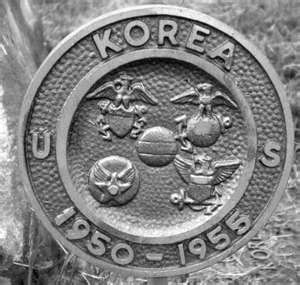 The Korean War exploded and at age seventeen I found myself in the Army training to be a combat engineer.
The Korean War exploded and at age seventeen I found myself in the Army training to be a combat engineer.
About six months after I arrived in Korea, I was traveling down the road near Inchon one day when I saw a huge sign written in both English and Korean. A refurbished Ford tractor with a mounted plow was parked in front of it. It stated that the tractor was a gift from the 4-H children of Texas, USA. I was absolutely stunned and filled with pride!
I returned to 4-H volunteer work at age nineteen after my stint in Korea, this time as a senior project leader.
Sometime later I married a Leipsic 4-H girl and moved out of town to work but was drawn back to my roots four years later. My children would also get the chance to be Leipsic 4-H members at the South Beaver Dam School. Jackson and Leipsic schools were both discontinued and closed.
I realize now that each 4-H project was really a tiny whisper of real life. I learned to value teamwork, plan a goal, build it, nurture it, solve any problems, record its progress and harvest the rewards of my effort. This prepared me for real life. Childhood 4-H discipline instilled values I use to this very day as I near eighty years of age.
I treasure the lifetime friends I made during my 4-H days and look back to my 4-H years as a time of pleasure, challenge and accomplishment. I see my life as a 4-H member and volunteer as one of the preeminent periods in my life.
Respectfully,
Bob Frankenstein


